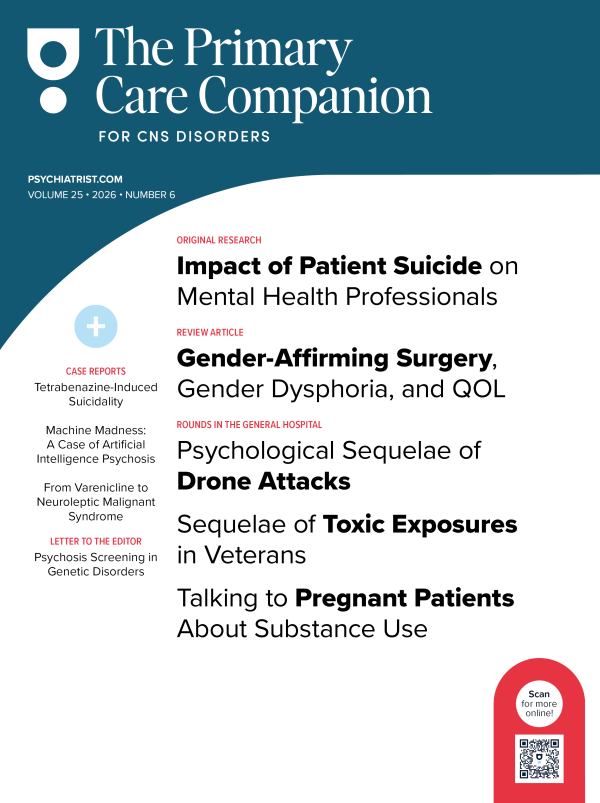Prim Care Companion CNS Disord 2023;25(3):22cr03363
To cite: İzci F, İzci S. Third-degree atrioventricular block with high-dose lamotrigine use. Prim Care Companion CNS Disord. 2023;25(3):22cr03363.
To share: https://doi.org/10.4088/PCC.22cr03363
© 2023 Physicians Postgraduate Press, Inc.
aErenköy Mental Health and Diseases Training and Research Hospital, Istanbul, Turkey
bDepartment of Cardiology, Kosuyolu High Specialization Training and Research Hospital, Istanbul, Turkey
*Corresponding author: Filiz İzci, MD, Erenköy Mental Health and Diseases Training and Research Hospital, Istanbul, 34100 Turkey ([email protected]).
Lamotrigine is a broad-spectrum anticonvulsant widely used to treat epilepsy and bipolar disorder. Evidence from case series and retrospective studies indicate that lamotrigine overdose is benign in general. Other than common side effects such as headache, skin rash, tremor, nausea, and vomiting, lamotrigine may rarely show cardiac side effects such as arrhythmia and QTc prolongation. In this report, a case in which a patient developed third-degree atrioventricular (AV) block while taking high-dose lamotrigine will be discussed.
Case Report
A 55-year-old married woman diagnosed with bipolar affective disorder, who had been followed up for about 10 years and had no cardiac history, was brought to the cardiology emergency department (ED) by ambulance with complaints including fainting, nausea, and vomiting. On physical examination, the patient’s blood pressure was 145/69 mm Hg, heart rate was 40 beats/minute, and oxygen saturation was 96%. Electrocardiography (ECG) showed third-degree AV block and junctional bradycardia. No pathology was detected on the routine blood tests. According to the medical history taken from the patient’s relatives, she was on a treatment regimen of quetiapine 100 mg/d, lamotrigine 200 mg/d, lithium 900 mg/d, and venlafaxine 150 mg/d for the last 6 months. It was stated that the patient, who had run out of other medications, took 600 mg of lamotrigine per day for the last 4 days because she only had lamotrigine on hand, resulting in loss of consciousness once and then constant dizziness, feeling of fainting, nausea, and vomiting. It was learned that the patient had no previous allergy to any drug and had not attempted suicide previously. While she was under medical observation in the ED, the patient received consultation with a psychiatrist. All psychiatric medications were stopped, and she was followed up in the coronary intensive care unit. A temporary pacemaker was implanted at the intensive care follow-up. The patient, whose follow-up ECGs showed improvement, returned to normal sinus rhythm, and she was discharged after a final psychiatric evaluation.
Discussion
Common toxic effects of lamotrigine include rash, sedation, and nausea/vomiting. In lamotrigine overdose, QRS prolongation, dysrhythmias, coma, and seizures have also been reported. Furthermore, similar to other anticonvulsants, lamotrigine can cause ataxia and nystagmus. It is also associated with hepatotoxicity and may cause serotonin syndrome and QTc prolongation.1 In a case report of a 26-year-old woman with severe menorrhagia after taking approximately 40 g of lamotrigine,2 the patient’s peak lamotrigine concentration was 73 mcg/mL, which was obtained on day 2 of hospitalization. She also exhibited more typical effects of lamotrigine toxicity including nystagmus, ataxia, slurred speech, and seizures, but she did not have QRS widening.2 Another case of cardiac arrest was observed in a patient who received high doses of lacosamide, cyclobenzaprine, and levetiracetam, which show a similar mechanism of voltage-gated sodium channel inactivation.3 Likewise, effects of lacosamide such as atrioventricular blockage (PR prolongation), atrial flutter, atrial fibrillation, sinus pauses, ventricular tachycardia, and cardiac arrest have been reported in the literature. Cyclobenzaprine is known for its potential of sodium channel blockage and ventricular arrhythmias, although cardiac toxicity alone is rare.3 Lamotrigine possibly causes cardiac arrhythmias with its sodium channel blocking effect, as in the present case. In another study,4 it was emphasized that most antiepileptic drugs prevent seizure formation by acting on voltage-dependent ion channels. It has also been stated that severe cardiac dysfunction can potentially be facilitated when antiepileptics are used in combination or at very high doses.4 Although the side effect range of drugs like lamotrigine, used in neuropsychiatry and chronic diseases such as epilepsy and bipolar affective disorder, is safe at high doses, observations are that it can cause cardiac arrhythmia, AV block, tachycardia-like symptoms, and even death.
Published online: May 11, 2023.
Relevant financial relationships: None.
Funding/support: None.
Patient consent: Consent was obtained from the patient to publish this case report, and information has been de-identified to protect anonymity.
ORCID: Filiz İzci: 0000-0003-0576-9487; Servet İzci: 0000-0002-4021-3444
References (4)

- Moore PW, Donovan JW, Burkhart KK, et al. A case series of patients with lamotrigine toxicity at one center from 2003 to 2012. Clin Toxicol (Phila). 2013;51(7):545–549. PubMed CrossRef
- Hajiali F, Nassiri-Asl M. Report of sever menorrhagia following maximum amount of lamotrigine overdose. Iran J Pharm Res. 2015;14(4):1289–1293. PubMed
- Chua-Tuan JL, Cao D, Iwanicki JL, et al. Cardiac sodium channel blockade after an intentional ingestion of lacosamide, cyclobenzaprine, and levetiracetam: case report. Clin Toxicol (Phila). 2015;53(6):565–568. PubMed CrossRef
- Hulbert J, Elger CE, Meyer R, et al. Antiepileptic drugs impair shortening of isolated cardiomyocytes. Front Neurol. 2017;8:133. PubMed CrossRef
Please sign in or purchase this PDF for $40.


